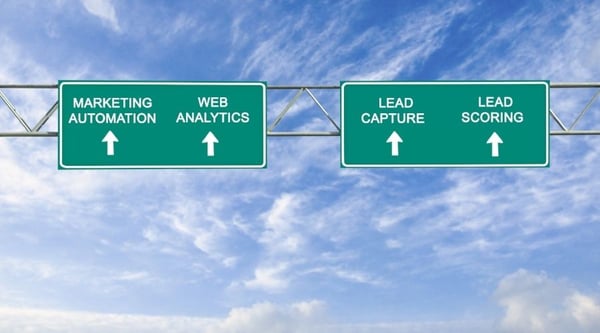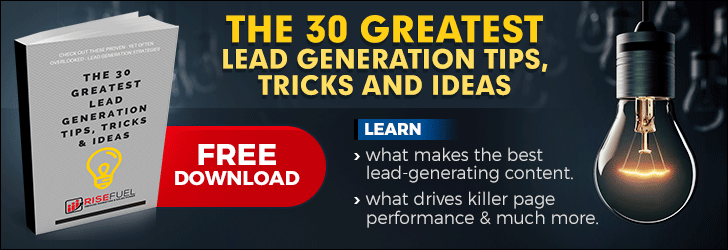
For B2B businesses, your ability to generate and nurture leads through your sales pipeline plays an integral role in the success of your business. You need a consistent stream of high-value leads in your sales pipeline to facilitate continued growth.
But in my work, I have found that many B2B companies are getting by without a solid plan in place. They throw things against the wall and see what sticks, never knowing where that next customer is coming from. For sustained success with lead marketing — you need a plan.
Installing a lead generation and a nurturing plan is a big part of what we do here at RiseFuel. Every B2B client that we work with goes through a thorough audit of their lead generation, nurturing, and sales enablement practices to make sure that they are making the most out of every visitor to your website.
Lead marketing strategies that we put together for our clients all follow the same basic steps — it’s the details that separate one offer from the next. As you evaluate your own lead generation and marketing strategies, make sure that you have all of the components in this basic framework:
Step #1: Identify Objectives
The first and arguably most important step in a multi-channel lead generation strategy is to define your objectives. What is it that you want to achieve? How are you going to measure your success? Through what channels would you like to generate those leads?
Typically, we define objectives with a client, we are looking at very specific metrics involving leads and revenue. I find that it best to assign a solid number to your goals. You don’t want to “grow revenue,” you want to “close sales at a 20% higher rate.”
Here are some example objectives that you might consider:
- Increase sales-qualified leads generated by X amount. The number of leads (or conversion rate of leads) that go through your marketing funnel and then are ready to pass to a sales rep. Not all reads will be ready to speak with a sales rep after interacting with your marketing, but the better your lead nurturing practices are the higher the rate will be.
- Increase sales closed by X amount. A simpler way for companies to measure success in lead generation and marketing. While you don’t have complete control over whether or not your leads will convert, the number of sales closed (and close percentage) provide insight into your lead generation and nurturing effectiveness.
It can be difficult to determine which metrics are best. You want to find that happy medium between generating enough leads and generating quality leads that are likely to become customers. You can generate a ton of leads but if none of them become customers then you have wasted a lot of time, effort, and budget.
Source: Instapage
Step #2: Lead Generation
The meat and potatoes of lead marketing. How will you actually be generating the leads that come into your system? I typically recommend a multi-channel approach, but some companies only have the budget to generate leads through one channel effectively. 53% of marketers say that half or more of their budget is allocated to lead generation.
While our long-term plans always involve inbound marketing, which will, in time, bring leads to your doorstep — it is a long-term strategy that takes time to come to fruition. Until you have the online presence for leads to come to you reliably, you can use a number of different tactics for generating leads:
- Buy a list. While this isn’t an option that I recommend, it is a viable option. There are legitimate companies that provide lead lists, but it is probably best if you work with someone that will generate an initial list of leads by hand to your specifications. Buying a generic list won’t produce the kind of results that you are hoping for.
- Prospecting and outreach. Manually identifying candidates for your offer, figuring out how to contact them, and then reaching out to them manually. You can cold call them, or use a tool like Hunter.io to find their email.
- PPC ads. PPC ads are an effective but budget-intensive way to get your offer in front of your audience and generate leads. If you have money to spend, PPC ads can be a great way to keep your pipeline filled with qualified prospects while you build out your long-term inbound marketing strategy.
No matter how you choose to generate leads, I always stress that it's important to focus on quality over quantity. You can generate all the leads you want but if they aren’t converting into sales then you need to rethink your strategy.
Understanding what channels and tactics you’d like to use for lead generation are crucial to developing the surrounding strategies that drive success.
Step #3: Develop Valuable Content
Developing valuable content is a big part of an effective inbound marketing strategy and a piece of every plan that I design here at RiseFuel. You need content on hand that you can refer customers to that will answer their questions, position your product as a solution to their problems, and continue to deliver value to them while you build rapport over time.
Valuable content can come in a range of different forms:
- Blog posts
- Email sequences
- White papers
- Case studies
- Podcasts
- Videos
Anything that provides value to your audience in an easily digestible way is a win for your lead nurturing practices. Make sure that you have a well-thought-out plan for putting together the type of content that your audience needs, or else you’ll quickly find that your leads aren’t converting.
If you can’t answer their questions and concerns thoroughly, they will look elsewhere.
Step #4: Nurture and Build Rapport
A great multi-channel lead marketing strategy hinges on your ability to nurture leads and build rapport with them over time. The lead nurturing process refers to the value and answers that you continually deliver to your leads as they go through the buyer’s journey.
The content creation I spoke about in the previous step plays a critical role here. Typically, I’ll work with clients to develop automated email sequences that deliver valuable content to prospects on a regular basis, mapping that content to specific points in the buyer’s journey.
Step #5: Sales Enablement
The final step in a fleshed-out lead marketing strategy is sales enablement. Sales enablement refers to your ability to provide your sales reps with the tools that they need to effectively sell your product.
This can refer to the tools that they use to track and facilitate success including customer relationship management tools, lead tracking tools, and communication tools. But it also refers to the content that you arm your sales reps with to help facilitate the sale.
Giving your sales reps the tools they need to be successful is absolutely critical. You can generate the best leads for your business but if your sales team isn’t able to close them, it’s all for naught.
Source: HighSpot
Tying It All Together
A great lead generation and nurturing strategy rely on your ability to put the pieces together. The entire process is made up of several steps and each step must be executed effectively for the entire process to work cohesively.
I work closely with clients to help them find a strategy that meshes with their current processes and positions them for success in B2B lead strategy management.














